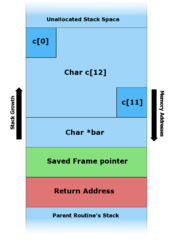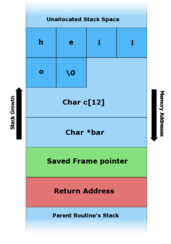
In programming and information security, a buffer overflow or buffer overrun is an anomaly whereby a program writes data to a buffer beyond the buffer's allocated memory, overwriting adjacent memory locations.
In computing, a segmentation fault or access violation is a fault, or failure condition, raised by hardware with memory protection, notifying an operating system (OS) the software has attempted to access a restricted area of memory. On standard x86 computers, this is a form of general protection fault. The operating system kernel will, in response, usually perform some corrective action, generally passing the fault on to the offending process by sending the process a signal. Processes can in some cases install a custom signal handler, allowing them to recover on their own, but otherwise the OS default signal handler is used, generally causing abnormal termination of the process, and sometimes a core dump.
In hacking, a shellcode is a small piece of code used as the payload in the exploitation of a software vulnerability. It is called "shellcode" because it typically starts a command shell from which the attacker can control the compromised machine, but any piece of code that performs a similar task can be called shellcode. Because the function of a payload is not limited to merely spawning a shell, some have suggested that the name shellcode is insufficient. However, attempts at replacing the term have not gained wide acceptance. Shellcode is commonly written in machine code.
A heap overflow, heap overrun, or heap smashing is a type of buffer overflow that occurs in the heap data area. Heap overflows are exploitable in a different manner to that of stack-based overflows. Memory on the heap is dynamically allocated at runtime and typically contains program data. Exploitation is performed by corrupting this data in specific ways to cause the application to overwrite internal structures such as linked list pointers. The canonical heap overflow technique overwrites dynamic memory allocation linkage and uses the resulting pointer exchange to overwrite a program function pointer.
Uncontrolled format string is a type of code injection vulnerability discovered around 1989 that can be used in security exploits. Originally thought harmless, format string exploits can be used to crash a program or to execute harmful code. The problem stems from the use of unchecked user input as the format string parameter in certain C functions that perform formatting, such as printf . A malicious user may use the %s and %x format tokens, among others, to print data from the call stack or possibly other locations in memory. One may also write arbitrary data to arbitrary locations using the %n format token, which commands printf and similar functions to write the number of bytes formatted to an address stored on the stack.
In computer security, hardening is usually the process of securing a system by reducing its surface of vulnerability, which is larger when a system performs more functions; in principle a single-function system is more secure than a multipurpose one. Reducing available ways of attack typically includes changing default passwords, the removal of unnecessary software, unnecessary usernames or logins, and the disabling or removal of unnecessary services.
Buffer overflow protection is any of various techniques used during software development to enhance the security of executable programs by detecting buffer overflows on stack-allocated variables, and preventing them from causing program misbehavior or from becoming serious security vulnerabilities. A stack buffer overflow occurs when a program writes to a memory address on the program's call stack outside of the intended data structure, which is usually a fixed-length buffer. Stack buffer overflow bugs are caused when a program writes more data to a buffer located on the stack than what is actually allocated for that buffer. This almost always results in corruption of adjacent data on the stack, which could lead to program crashes, incorrect operation, or security issues.
A "return-to-libc" attack is a computer security attack usually starting with a buffer overflow in which a subroutine return address on a call stack is replaced by an address of a subroutine that is already present in the process executable memory, bypassing the no-execute bit feature and ridding the attacker of the need to inject their own code. The first example of this attack in the wild was contributed by Alexander Peslyak on the Bugtraq mailing list in 1997.
Code injection is the exploitation of a computer bug that is caused by processing invalid data. The injection is used by an attacker to introduce code into a vulnerable computer program and change the course of execution. The result of successful code injection can be disastrous, for example, by allowing computer viruses or computer worms to propagate.
In computing, an uninitialized variable is a variable that is declared but is not set to a definite known value before it is used. It will have some value, but not a predictable one. As such, it is a programming error and a common source of bugs in software.
In computer science, a call stack is a stack data structure that stores information about the active subroutines of a computer program. This type of stack is also known as an execution stack, program stack, control stack, run-time stack, or machine stack, and is often shortened to simply "the stack". Although maintenance of the call stack is important for the proper functioning of most software, the details are normally hidden and automatic in high-level programming languages. Many computer instruction sets provide special instructions for manipulating stacks.

Hacking: The Art of Exploitation (ISBN 1-59327-007-0) is a book by Jon "Smibbs" Erickson about computer security and network security. It was published by No Starch Press in 2003, with a second edition in 2008. All of the examples in the book were developed, compiled, and tested on Gentoo Linux. The book also comes with a CD that contains a Linux environment with all the tools and examples used in the book.
setjmp.h is a header defined in the C standard library to provide "non-local jumps": control flow that deviates from the usual subroutine call and return sequence. The complementary functions setjmp and longjmp provide this functionality.
In computer security, a NOP slide, NOP sled or NOP ramp is a sequence of NOP (no-operation) instructions meant to "slide" the CPU's instruction execution flow to its final, desired destination whenever the program branches to a memory address anywhere on the slide.
Secure coding is the practice of developing computer software in such a way that guards against the accidental introduction of security vulnerabilities. Defects, bugs and logic flaws are consistently the primary cause of commonly exploited software vulnerabilities. Through the analysis of thousands of reported vulnerabilities, security professionals have discovered that most vulnerabilities stem from a relatively small number of common software programming errors. By identifying the insecure coding practices that lead to these errors and educating developers on secure alternatives, organizations can take proactive steps to help significantly reduce or eliminate vulnerabilities in software before deployment.
Return-oriented programming (ROP) is a computer security exploit technique that allows an attacker to execute code in the presence of security defenses such as executable space protection and code signing.
JIT spraying is a class of computer security exploit that circumvents the protection of address space layout randomization and data execution prevention by exploiting the behavior of just-in-time compilation. It has been used to exploit the PDF format and Adobe Flash.
Blind return oriented programming (BROP) is an exploit technique which can successfully create an exploit even if the attacker does not possess the target binary. BROP attacks shown by Bittau et al. have defeated address space layout randomization (ASLR) and stack canaries on 64-bit systems.
Control-flow integrity (CFI) is a general term for computer security techniques that prevent a wide variety of malware attacks from redirecting the flow of execution of a program.
Sigreturn-oriented programming (SROP) is a computer security exploit technique that allows an attacker to execute code in presence of security measures such as non-executable memory and code signing. It was presented for the first time at the 35th IEEE Symposium on Security and Privacy in 2014 where it won the best student paper award. This technique employs the same basic assumptions behind the return-oriented programming (ROP) technique: an attacker controlling the call stack, for example through a stack buffer overflow, is able to influence the control flow of the program through simple instruction sequences called gadgets. The attack works by pushing a forged sigcontext structure on the call stack, overwriting the original return address with the location of a gadget that allows the attacker to call the sigreturn system call. Often just a single gadget is needed to successfully put this attack into effect. This gadget may reside at a fixed location, making this attack simple and effective, with a setup generally simpler and more portable than the one needed by the plain return-oriented programming technique.




